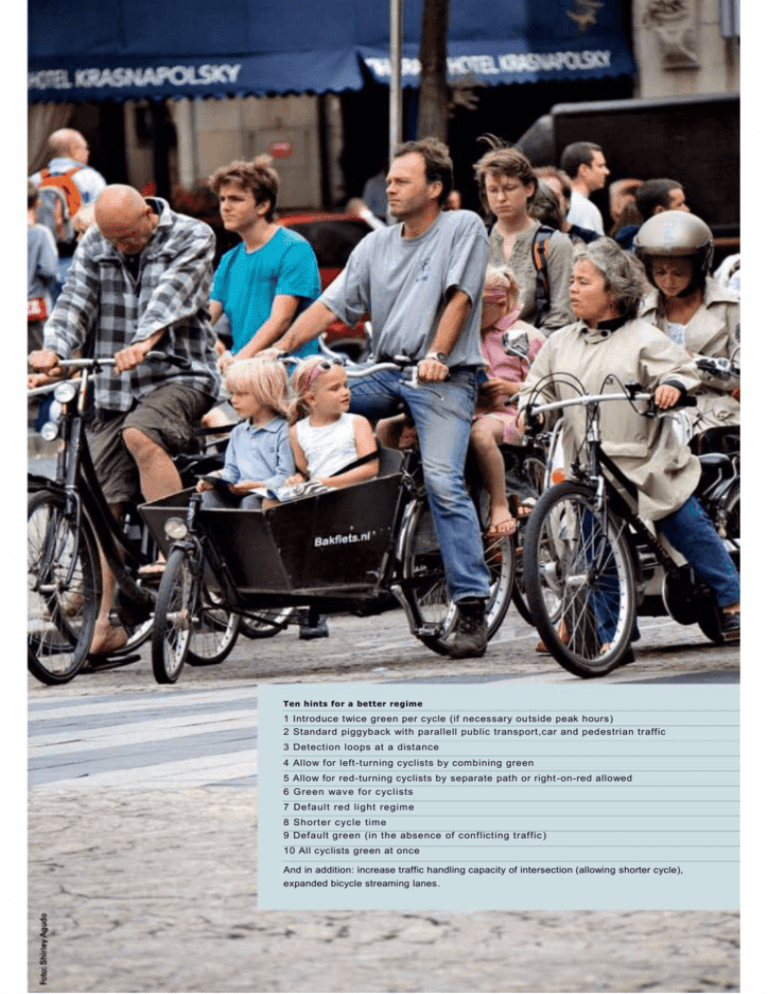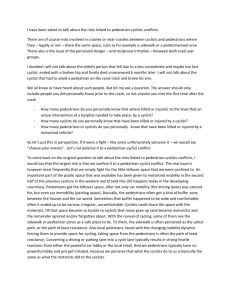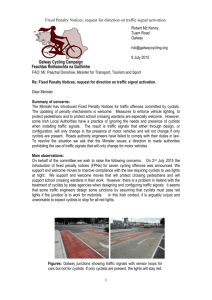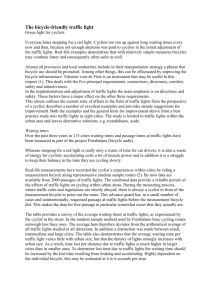Cyclists still subordinate in traffic light regime: > ` Twice green almost
advertisement

Ten hints for a better regime 1 Introduce twice green per cycle (if necessary ou tside peak hours) 2 Standard piggyback with parallell public transport,car and pedestrian traffic 3 Detection loops at a distance 4 Allow for left-turning cyclists by combining green 5 Allow for red-turning cyclists by separate path or right -on-red allowed 6 Green wav e for c yc lists 7 Default red light regim e 8 Short er c yc le tim e 9 Default green (in the absence of conflicting traffic ) 10 All cyclists green at once And in addition: increase traffic handling capacity of intersection (allowing shorter cycle), expanded bicycle streaming lanes. Cyclists still subordinate in traffic light regime : > ‘ Twice green almost always feasible’ Ron Hendriks The problem has been around for a long time: cyclists complaining of long waiting times at traffic lights, or deciding to run the red light. Solutions have been known for a long time as well, but are often simply not implemented. The main issue is bringing cyclists to the attention of traffic control managers . Moreover the greatest advances, quite logically, have been Cyclists spend a relatively large part of their time waiting for traffic made in towns that scored badly in the first Fietsbalans’. lights. An analysis by Fietsersbond on the basis of Fietsbalans Besides long waiting times cyclists also detest stopping often. reveals that traffic lights cause three-quarters of all waiting time That can be explained. ‘The energy use of stopping and for cyclists. In small towns waiting may not be too bad, but in large starting just once is equal to cycling 100 to 200 metres,’ towns traffic light delays may run to 45 seconds a kilometre. And calculates Theo Zeegers. cyclists do not like that, as demonstrated by Fietsberaad research There are however towns with clear improvements in waiting (Fietsberaad publication 4, 2004). A cycle time over 90 seconds times and/or stopping chances, like Hilversum, Den Haag and within the built-up area is not appreciated, was the result. Nijmegen. Theo Zeegers - Fietsersbond: ‘‘Energy use of stopping and starting just once is equal to cycling 100 to 200 metres”. Lack of attention There is not much extra to be gained in a technically good regime, there are after all no more than 60 seconds in a minute. But if the regime still has room, there are definitely gains to be But in recent years the situation has improved, according to made, often for all traffic participants,’ Zeegers continues. Theo Zeegers of Fietsersbond, comparing the data from ‘One of the problems you face is for instance that vetag systems Fietsbalans 1 and 2. An analyses demonstrates that average giving priority to public transport throw a spanner in the works. delay has been reduced by 2 seconds a kilometre, but 40 per The irregularities such a system entails have more cent of this improvement can be attributed to better traffic light consequences than people generally assume and may greatly regimes. The rest has other causes. ‘For instance because affect waiting times. But the most important reason that many redundant traffic lights are switched off - a well-known example regimes are suboptimal is a lack of money and attention. And the is the route Centraal Station-Uithof in Utrecht (Neude) - but also nice thing about a Fietsbalans benchmark is that it demonstrates because traffic lights have been replaced by roundabouts. things can be better. That a bad town cannot hide behind the argument that traffic has increased so much.’ Twice green Bo Boormans, director and traffic control expert of DTV Consultants fully endorses this. ‘Many towns possess or prepare a traffic light memorandum. This contains requirements regarding design and maintenance of traffic light systems. But the procedural strategy is discussed as well. I find that bicycles are often glossed over. Therefore we always attempt to involve everyone concerned when we are drawing up such a memorandum: policymakers, traffic control experts, public transport and cyclists. In an interactive session everyone can indicate what is important.That’s when it becomes apparent first of all that bicycle people sometimes take a lot of persuading for something like that because they feel they do not possess sufficient knowledge. And if they do participate, The average delay has decreased somewhat in recent years, according to Fietsbalans, but only 40 per cent of the improvement is due to better traffic light regimes. The rest has other causes. I Fietsverkeer 24 I maart 2010 I 29 they often find it hard to formulate and substantiate their quality level. Recently the lights at Stratumsedijk/Jorislaan wishes, in contrast to for instance representatives for public have been replaced. Cyclists are awarded a higher priority transport, who stand up for themselves and are well - here than cars, as well as two green phases per cycle. In prepared’. According to Boormans bicycle people need to actual practice, however, the intersection ground to a halt learn to put their foot down, too. ‘And for that you really do due to the extra green phase for cyclists. That was a reason not need to know how such a regime comes into being. A little for the traffic control engineers to remove the extra green basic knowledge on delay chances, green phases and waiting phase for the time being, allowing better flow of traffic.’ times will go a long way.’ According to Bas Braakman this example demonstrates This procedure has also been followed in Eindhoven, which eventually lead to a traffic -light memorandum with an obvious place for cyclists. ‘In the past the main issue was handling car traffic. In future the handling of public transport and cyclists will be more prominent,’ according to the anyway that there is not always a good underst anding of the consequences of implementation of the traffic -light memorand um on traffic management in town. ‘W e also lack a protocol how to proceed when handling runs into problems due to extra green for cyclists.’ memorandum that promises cyclists maximum waiting times of 20 seconds on the primary bicycle network and 40 seconds on the secondary bicycle network. And the bicycle has ascended in the regime hierarchy.Yet in actual practice matters prove to be more intractable here as well and traffic control engineers are not easily convinced, according to Eindhoven civil servant Bas Braakman. ‘When replacing traffic lights the basis for the programming is the defined Priority transport modalities at traffic lights in Eindhoven according to Beleidsnota Verkeerslichten 1 Car wit h priority 1 (ring road Eindhov en*) 2 High-grade public t rans port / f low axes 3 Car with priority 2 (major radials) 4 Net work heav y pedestrian flows 5 Primary bic ycle net werk/Ster bicycle net work 6 Residential public transport net work 7 N et wo rk go ods t rans po r t 8 Car with priority 3 (other ‘secondary’ radials) 9 Sec ondary bic yc le net wo rk 10 Special pedestrian flows 11 Car with priority 4 or 5 (other main routes) 12 Pedestrian crossings at residential/welfare sites 13 Car on neighbourhood and preliminary distric t connectors * Rough description: priorities have been separately determined by stretch of road in Beleidsuitgangspunten Netwerkvisie Beter Bereikbaar Zuidoost Brabant (2004). A traffic-light memorandum may for instance state maximum waiting times and regime hierarchy. 30 I Fietsverkeer 24 I maart 2010 I Evergreen Evergreen consists of a series of LED sensors located at approximately five metre intervals in the road surface, several hundred metres in front of a traffic light regulated intersection. A similar system is already operative in Odense (Denmark). The LEDs display green ‘blocks’. A nyone cycling within the green block will be guaranteed a green light at the approaching intersection. The foremost green LEDs move slower than the hindmost. This slows down the cyclists at the front of the block and speeds up those at the back. Each cycli st thereby reaches the traffic light at exactly the right moment (provided he matches his speed to the LEDs). The concept is by DTV Consultants, who are still looking for road maintenance authorities to implement this. Rotterdam in any case is seriously interested. Yet according to Bo Boormans twice green is the most obvious way to reduce waiting times for cyclists. ‘Twice green is feasible in nearly all intersections. And in case it does cause problems in peak hours, you may switch off the twice green regime at those times, if necessary. I think that waiting Standards for a bicycle-friendly regime according to times for cyclists - outside peak hours anyway - can be Ontwerpwijzer Fietsverkeer (CROW). reduced to 60 per cent in almost all cases. Breda for instance has had active and successful policies since 1998 to greatly 45 reduce waiting times or cyclists, among other ways by twice 40 green phases, if necessary at the expense of motorists’ 35 30 waiting times. It is important in this respect that a decision is SLECHT 25 made, and people are not resigned to accepting that extra 20 room in a regime is automatically awarded to motorists.’.’ 15 MATIG GOED 10 5 Green wave 0 The various ways of how to handle cyclists faster are well known by now (see hints). It now appears to be more a 0,50 matter of political courage or priority to optimise the uses of 0,55 0,60 0,65 0,70 0,75 0,80 0,85 0,90 0,95 stopkans existing knowledge. Or are there any major technological advances to be expected in this field? Boormans does not think so. ‘It is not a matter of improved traffic models - which are rarely used anyway - or smarter control software, that has by now crystallised out.’ And real network solutions wave is realised by recommending a particular speed to where traffic regimes automatically react to the amount of cyclists. For the time being by means of lights along the road traffic in a network are still very much in an infancy stage. It for instance, in future maybe by means of a display on the is moreover unsure to which degree cyclists would benefit, cyclist’s handlebars. Such a green wave is easier to use in since dynamic traffic management in an urban environment double implementation anyhow. Rain sensors providing more will probably focus much more on cars when cyclists’ green to cyclists are of course nice and politically always interests are not forcefully defended’, Boormans fears. successful. But that raises the question why you wouldn’t Bo Boormans - DTV Consultants ‘By now control software has crystallised out .’ arrange matters positively all of the time, with priority for cyclists.’Theo Zeegers advocates another approach: ‘The intersection designer and traffic control engineer should preferably cooperate in the early planning stages in cases of ‘The software-based quality centre is however a useful tool, allowing monitoring of waiting times for cyclists, among others, in actual practice. Green waves for cyclists are of course great, although technically hard to achieve. But when traffic lights are less than 200 metres apart, that is something to be considered anyway. We are ourselves working on solutions where a green wave is realised by recommending a particular speed to new intersections and drastic re-designs of intersections. And omit traffic lights if at all possible. Because t hat causes the least delays. Or else investigate all technical possibilities step by step.’’ > See also fietsberaad.nl > Kennisbank > Trends in oponthoud voor fietsers binnen de bebouwde kom, Theo Zeegers (2010). > See also fietsberaad.nl > Voorbeeldenbank > Kruispunten > Verkeerslichten. I Fietsverkeer 24 I maart 2010 I 31 1,0





